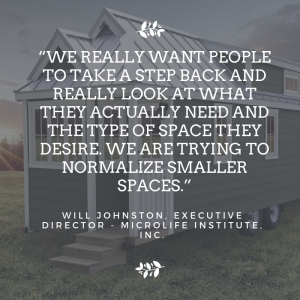Living Small in Atlanta
In the 1960s and 70s, the average home size was 1,600 square feet for 3.5 people. Today, houses average 2,600 square feet for 2.5 people.
As houses are getting bigger, families are getting smaller, inhabiting even less of their space. In fact, the average person only interacts with about 250 square feet of their current home (their bedroom, kitchen, and bathroom).
The MicroLife Institute of Atlanta is a research, education, advocacy, and pilot program organization promoting the microbuild movement and smaller living in Atlanta.
“We really want people to take a step back and really look at what they actually need and the type of space they desire so they as a person can flourish,” Will Johnston, Executive Director of MicroLife, said.
Johnston said that the tiny living movement was already a big concept in Europe and Asia. Trying to expand awareness in the US, helping individuals understand how to utilize space better so wasted space is limited.
“I wholeheartedly believe that a microliving environment pushes you out into the community and pushes you to be a better person because you do get bored at home,” Johnston said. “You don’t have to do all the things at home. We forget that happiness is actually interacting with people and having experiences.”
“With such big spaces, we have money going out of your pocket from heating and cooling, wasted space, and wasted materials,” he added. “We have defined success as a huge house, lots of cars, and stuff.”
“If you want to be happy, focus on the people and the experiences, then happiness will come to you,” Johnston said. “You need to think beyond the walls about how you are going to interact with your neighbors and build your outside environment.”
Johnston said that a barrier to an increase microliving presence is showing builders and developers that it is a viable, profitable option. “We need to show developers that it is profitable and there is a huge market behind it,” he said.
In fact, in East Point, 40 tiny homes (under 1,000 square feet) are going up with a waitlist of 1,400 owners. In an online survey conducted by MicroLife, it was found that 52% of the 1,400 participants were salaried employees looking to downsize to a space between 250 and 600 square feet. Those respondents varied in age from 18 to 85.
“We are creating personalized spaces and allowing people to not interact with each other,” he said. “We only have a blip of time on this planet, and we are worried about what our neighbor is thinking.”

Johnston runs a group through Meetup.com, and his organization can also be found at microlifeinstitute.org. Individuals can also sign up for an informational newsletter at www.tinyhouseatlanta.org.
